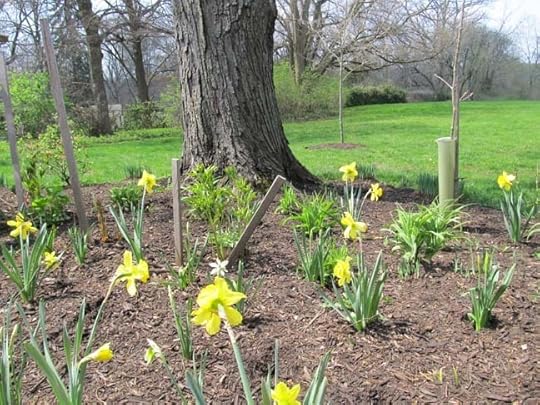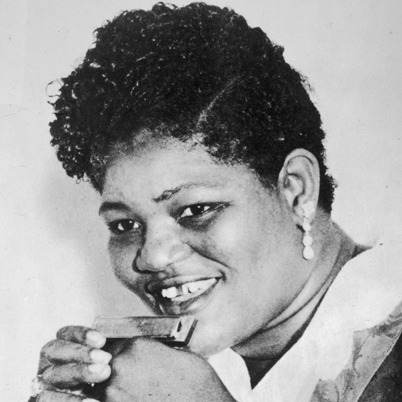Lie, steal, remake?

[Up for the first time: My daffodils making the eternal Spring new.]
How ‘lying’ and remaking spur creativity in fiction & nonfiction.
For oft, when on my couch I lie
In vacant or in pensive mood,
They flash upon that inward eye
Which is the bliss of solitude;
And then my heart with pleasure fills,
And dances with the daffodils.
—from “I Wandered Lonely as a Cloud” by William Wordsworth
[Blues icon Big Mama Thornton.]
As a lifelong writing student, I’ve resisted writing prompts—a lazy doubting stubbornness that’s fading as I see repeatedly in my classes their utility and power. Spurred by an exercise, my “Writing Life Stories” students have just produced some of their best work of the semester.Here’s the prompt, “Tell a Lie, Tell the Truth,” from Lee Martin. I got it from his wonderful blog (I’ve probably changed some of the wording for my students, who by and large are not writing majors and are taking their first creative writing class of any kind):
1. Open a piece of creative nonfiction by telling a lie about yourself. Don’t stop to think. Just go with the first thing that comes to you. Be as outrageous as you’d like.
2. Admit the lie, using this prompt: “That’s not true at all. The truth is. . .”
3. Embrace the lie, using this prompt: “Oh, but how I wish it were true, for if it were. . .”
4. Let the lie bring material to the surface that you might be hesitant to explore otherwise by using this prompt: “Why would I spin a lie like that? When I think of that lie, I also think of. . .”
*The objective is to let fiction (the lie) provide a doorway into truths about your life that you might not otherwise notice. This can sometimes open our material to us in profound ways.
Though I can’t stop thinking about some of them, I won’t retell the stories my students told. But suffice it to say that their essays’ opening lies—in their yearning and often-iconic specifics, images maybe borderline trite in a straight usage—take on such power, resonance, and frequently sadness as we learn the truth. Yet the retrospective wisdom fostered by the nature and placement of the truth-telling narrator makes it all moving but emotionally bearable, and a gift.
Over at Bill and Dave’s Cocktail Hour, Bill Roorbach takes lying or simple appropriation to new creative heights in his “Bad Advice Wednesday: Remake.” He says to take a story or essay you admire and retell it in your own way.
By stealing in this post, I’ve sort of done that. Except my two sources are advising more ultimate originality than I’m displaying here so far. One says, Tell a lie and immediately admit it and speculate on it, revealing who you really are; the other says, Steal a plot and write the heck out of it and watch it become your creation, even unto plot.
It strikes me that a perfect example of what Bill Roorbach, at least, is talking about is essayist and essay scholar Robert Atwan’s recent brilliantly conceived and executed re-imaging of The Great Gatsby, the story retold from Tom Buchanan’s viewpoint for The Believer.
Meanwhile, Lee Martin has posted on his blog, The Least You Need to Know, what’s more than a post: it’s a flash essay, “An Easter Sunday Memory,” only 441 words; it is a poignant tableau of 10-year-old him and his parents eating out at a restaurant, with powerful use of the retrospective view at the end as Lee pulls the camera way, way back.
As I told him, I think there’s a future prompt here!
Such as:
Read Lee Martin’s flash essay “An Easter Sunday Memory,” and write your own vignette that takes place during a holiday; start in scene and flow background explanations into the unfolding action; step back at the end and speak from now, from your wisdom of what your characters don’t know awaits them.
His new post is illustrated by a photograph of a daffodil that fairly flutters in a cool spring breeze. That’s partly because it’s true, they do come early when chills abide, and largely because William Wordsworth spied a “host of golden daffodils” “fluttering and dancing in the breeze.” His perceptions have seeped into Homo sapiens’ DNA. We’re not so original—nor need we be.
A former neighbor and hired helper of mine, whom I portray as Sam in my book Shepherd: A Memoir, used to call daffodils “Easter flowers.” I doubt Sam knew their “real” name, and his folk-poetry label for the Narcissus species spoke volumes.
Right now, in a perennial bed paces from where I write, my daffodils ordered last Fall are up for the first time. I’d planted the bulbs in the root system of a massive silver maple, and feared I hadn’t gotten them deep enough. Maybe they didn’t all make it, but at least some are blooming. Their white and yellow faces form a luminous statement of hope and joy—indeed of rebirth—in this weary world. There they’ll endure, Spring’s very essence, annually offering a welcome greeting. Bringing a reminder, as Sam had it, of what’s eternal and yet forever so new.
[See also my post on Austin Kleon's book Steal Like an Artist. And now below, Janice Joplin makes Big Moma Thornton's "Ball and Chain" into her own cry from the heart, in 1968 at the Monteray Pop Festival.]




